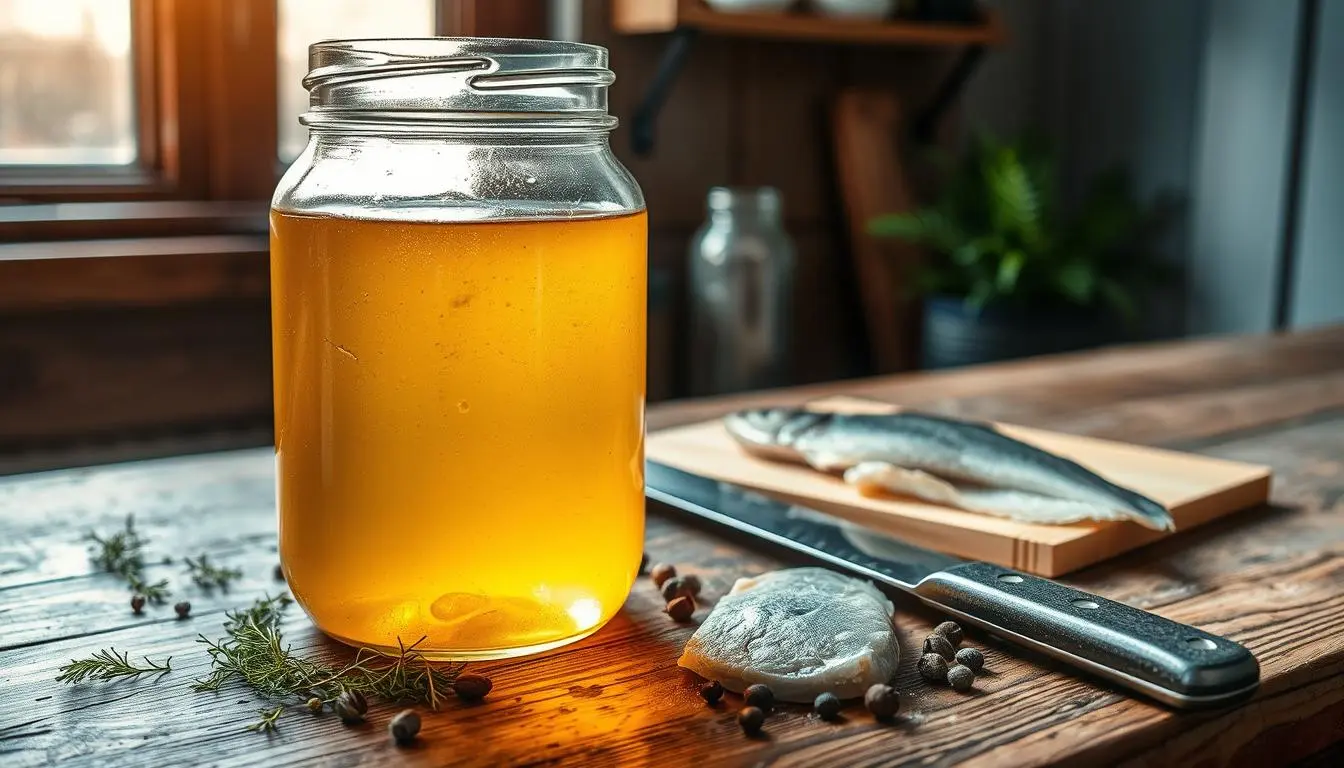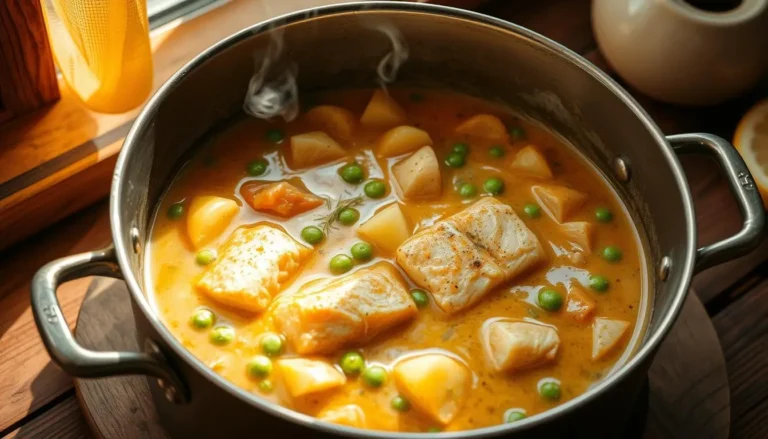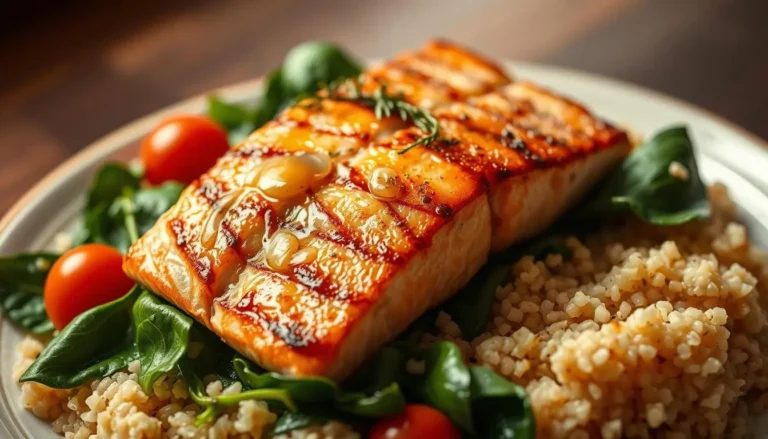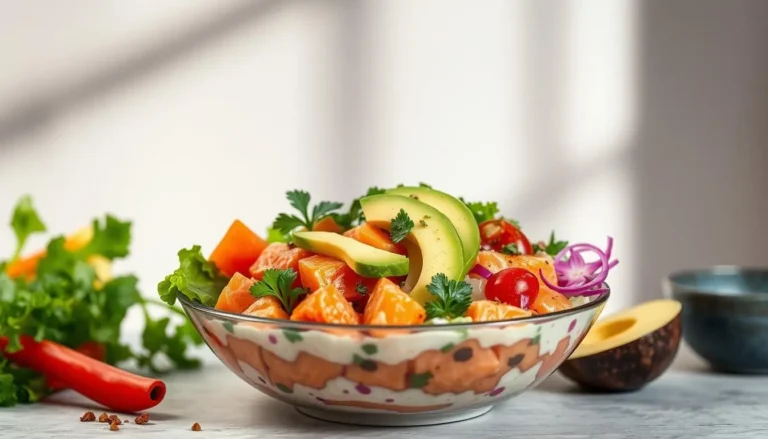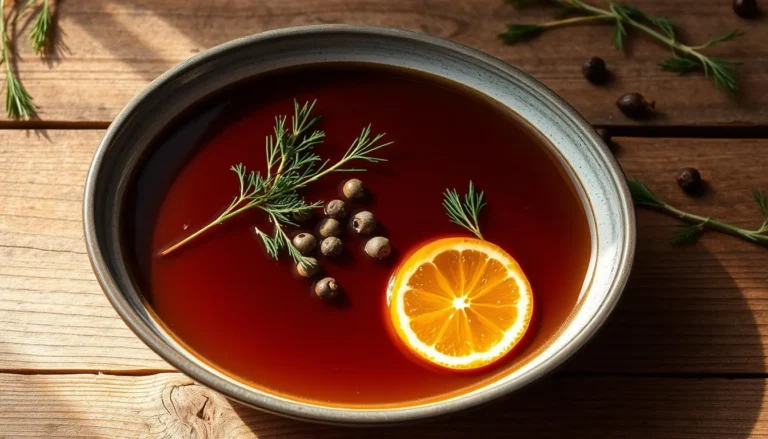How to Make the Best Smoked Fish Brine at Home
Every culinary adventure starts with a passion for turning ordinary ingredients into amazing dishes. Smoking fish is more than a cooking method—it’s an art form. It connects us to centuries of food preservation traditions.
Creating the perfect smoked fish brine recipe is like unlocking a secret flavor profile. It takes your seafood from simple to spectacular. Your journey into mastering smoked fish brine starts with understanding flavor infusion.
A well-crafted smoked fish brine does more than season—it transforms texture, locks in moisture, and prepares your fish for an incredible smoking experience. Whether you’re a home cook or aspiring chef, this foolproof smoked fish brine recipe will revolutionize your culinary skills.
Table of Contents
Understanding the Science Behind Fish Brining
When you make a brine for salmon smoking, knowing the science behind it can change your cooking game. Brining is not just about soaking fish in saltwater. It’s a complex process that makes flavors better, the texture softer, and keeps the fish fresh longer.
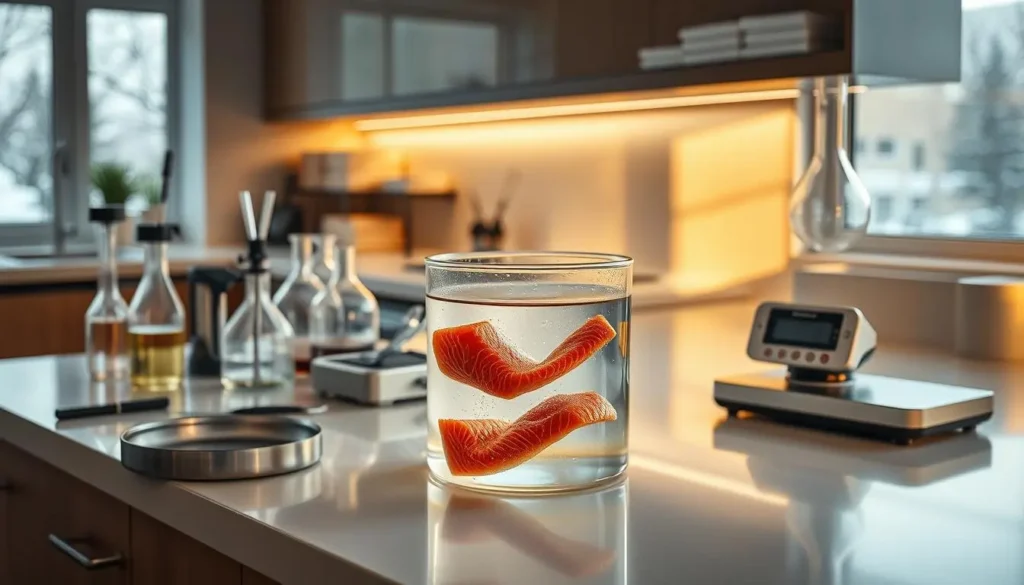
The science of brining is all about osmosis and diffusion. When you make a brine for salmon, some cool chemical things happen:
- Salt pulls moisture out of the fish through osmotic pressure
- Proteins in the fish start to break down
- Flavors get deep into the fish’s meat
Chemical Processes During Brining
Brining uses salt to manage moisture. The salt outside the fish pulls water molecules out, restructuring the proteins. This helps keep moisture in during smoking and makes the fish tender.
How Salt Penetrates Fish Tissue
Salt is key in your brine for salmon smoking. It breaks down proteins, spreading moisture and flavor evenly. Salt creates tiny channels, letting flavors and moisture get deep into the salmon, making it taste better and feel softer.
Role of Sugar in Brining
Sugar in your brine does more than add sweetness. It balances the salt and keeps moisture in. Sugar molecules work with proteins, creating a caramelized taste that boosts the salmon’s flavor during smoking.
Essential Equipment for Successful Fish Smoking
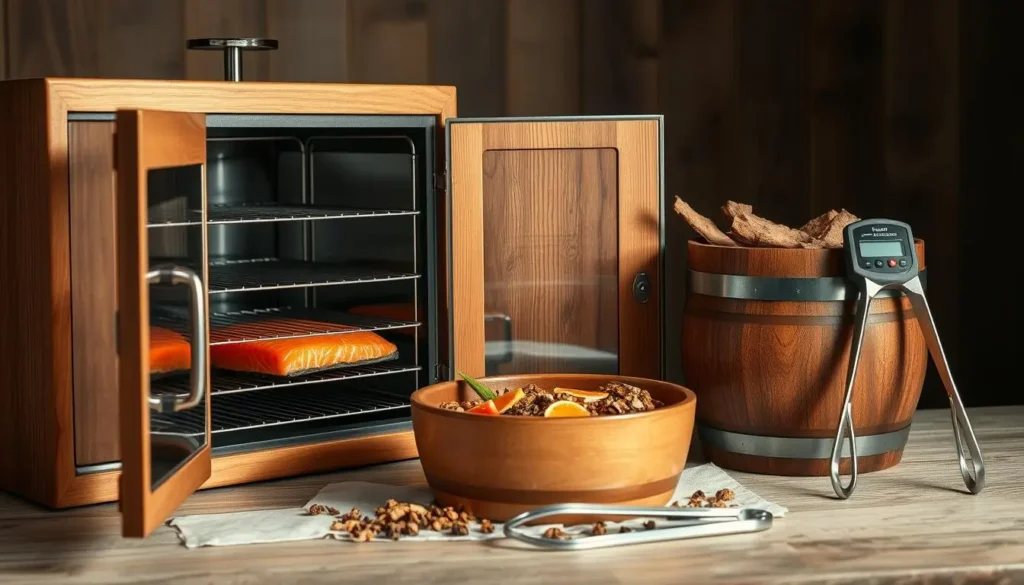
To make a tasty smoked salmon brine, you need more than just ingredients. The right tools can make a big difference. Whether you’re new or experienced, having the right equipment is key to smoking fish perfectly.
Your essential smoking toolkit should include:
- A reliable smoker (electric, charcoal, or wood-fired)
- Digital meat thermometer for precise temperature monitoring
- Large non-reactive brining container
- Sturdy smoking racks or trays
- High-quality wood chips or pellets
- Protective heat-resistant gloves
- Long-handled tongs
When picking a smoker, think about temperature control, size, and fuel type. Electric smokers keep temperatures steady, while charcoal and wood-fired ones give a real smoky taste. Get a digital thermometer to make sure your fish hits 145°F safely.
Your brining container should be big and made from non-reactive stuff like glass, ceramic, or food-grade plastic. This stops chemical reactions that could mess up your smoked salmon’s flavor. Pick smoking racks that let air flow well and make handling fish easy.
Wood chips are key for flavor. Try apple, cherry, and alder to boost your smoked salmon’s taste. Always soak wood chips for at least an hour before smoking to avoid burning and keep the smoke steady.
Selecting the Perfect Fish for Smoking
Choosing the right fish is key to making delicious smoked fish. Not all fish are good for smoking. Knowing the differences can make your food taste better.
Best Fish Species for Smoking
Some fish are better for smoking than others. Oily fish like salmon, trout, and mackerel are great. They have a rich taste and soak up flavors well.
- Salmon (Atlantic, Coho, Chinook)
- Rainbow Trout
- Mackerel
- Whitefish
Fresh vs Frozen Fish Options
Think about the fish quality when smoking. Fresh fish is best, but good frozen fish works too.
| Fresh Fish | Frozen Fish |
|---|---|
| Optimal flavor | Convenient storage |
| Premium texture | Often flash-frozen at peak freshness |
| Higher cost | More budget-friendly |
Quality Indicators to Look For
When picking fish for your smoked salmon brine, look for these signs:
- Eyes: Bright, clear, and free from cloudiness
- Flesh: Firm and elastic, springs back when pressed
- Color: Vibrant and uniform without discoloration
- Smell: Fresh, clean aroma with no off-putting odors
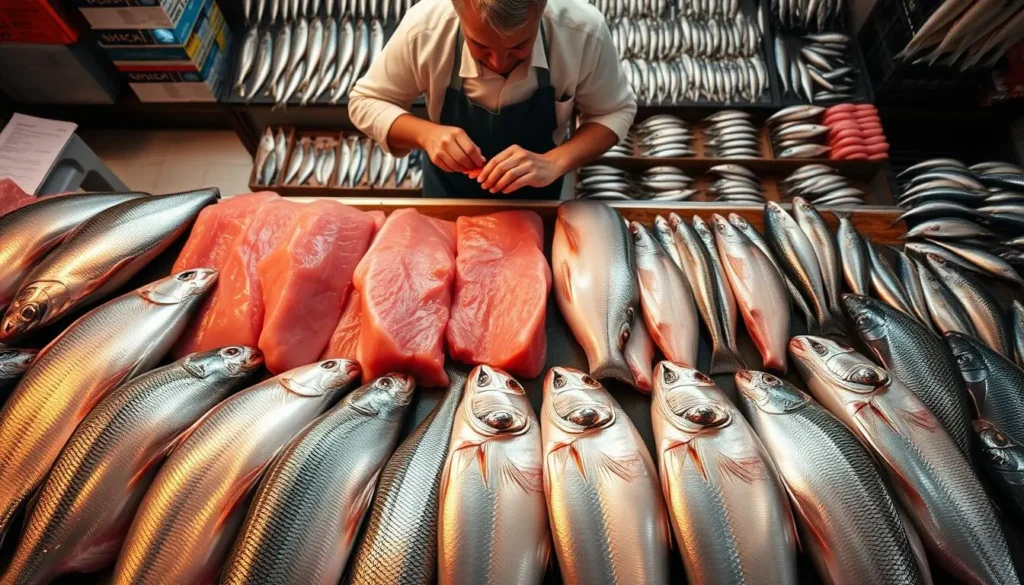
Pro tip: If you’re buying salmon, October is National Seafood Month—a perfect time to explore premium smoked fish options!
The Ultimate Smoked Fish Brine Recipe
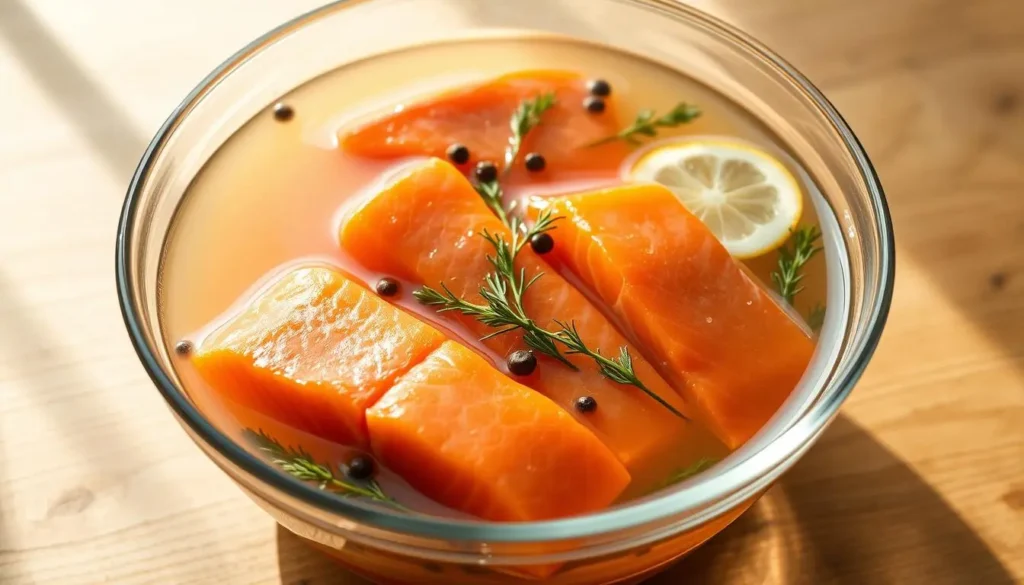
Making the perfect fish brine for salmon needs care and knowing how flavors work together. This brine will turn your fish into a dish full of deep, rich tastes.
The best brine recipe uses special ingredients for a great taste. You’ll need:
- 1 tablespoon Morton Coarse Kosher Salt
- 1/4 cup brown sugar
- 2 tablespoons fresh dill
- 2-3 crushed garlic cloves
- 1 teaspoon black peppercorns
- Optional: 2 tablespoons maple syrup
When making your brine, keep these important amounts in mind:
| Ingredient | Quantity | Purpose |
|---|---|---|
| Kosher Salt | 1 tablespoon | Flavor enhancement |
| Brown Sugar | 1/4 cup | Balance saltiness |
| Fresh Dill | 2 tablespoons | Aromatic profile |
Make your brine with water at room temperature. Mix the dry ingredients first, then add water to dissolve. Make sure your fish is fully covered.
How long you brine is key: 8 to 12 hours for the best flavor. Keep the fish cold to stay safe.
Pro tip: For best results, use fresh salmon fillets between 1-inch and 1½-inches thick.
After brining, dry your salmon well. Let it rest to form a pellicle. This sticky surface helps the smoke stick well.
Key Ingredients and Their Functions
To make the best brine for smoking fish, you need to know the important ingredients. Each one helps with flavor, texture, and keeping the fish fresh.
Types of Salt for Brining
Salt is the main part of any brine for fish to smoke. Different salts have their own special qualities:
- Kosher salt: Gives a clean, pure taste
- Sea salt: Adds a rich mineral flavor
- Pickling salt: Makes sure the salt crystals are the same size
| Salt Type | Flavor Profile | Recommended Usage |
|---|---|---|
| Kosher Salt | Clean, mild | Primary brining salt |
| Sea Salt | Mineral-rich | Specialty brines |
| Pickling Salt | Neutral | Precise measurements |
Sweeteners and Their Effects
Sweeteners help balance the salt and add special flavors:
- White sugar: Adds a neutral sweetness
- Brown sugar: Gives a caramel taste
- Honey: Adds floral notes
- Maple syrup: Brings a rich, complex sweetness
Optional Aromatics and Spices
Adding certain aromatics can make your brine even better:
- Fresh herbs: Dill, thyme, rosemary
- Citrus zest: Lemon, orange
- Garlic: Adds a strong flavor
- Peppercorns: Adds a subtle heat
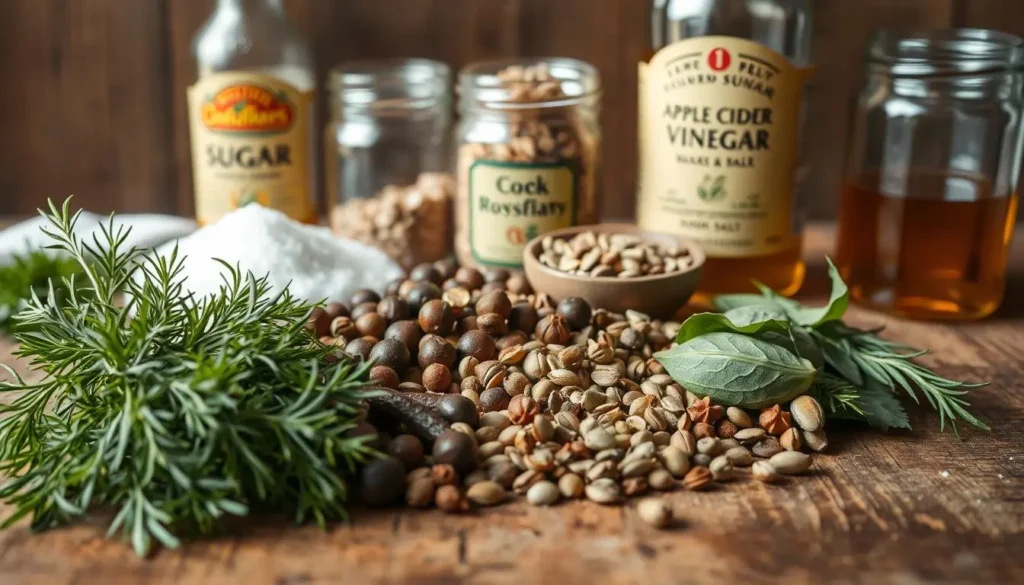
Creating amazing smoked fish is all about finding the right balance. Try different amounts to find your favorite brine recipe.
Step-by-Step Brining Process
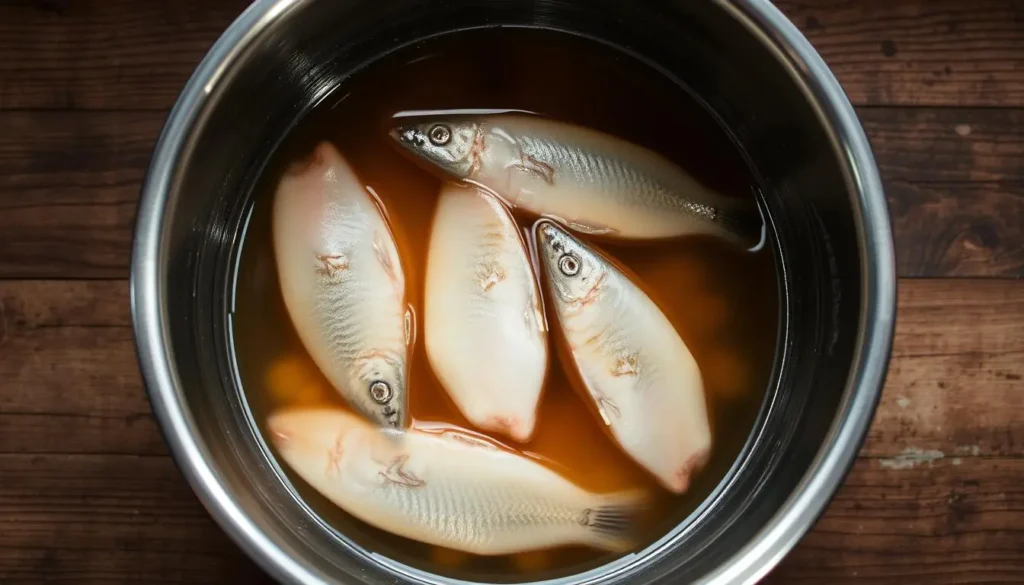
Making the perfect smoked fish brine is all about precision and care. It turns simple salmon into a flavorful, moist treat.
Here’s how to make a top-notch brine for smoking salmon:
- Prepare the Brine Solution
- Dissolve 1/2 cup kosher salt
- Add 1/3 cup brown sugar
- Mix with 4 cups of water (1 cup warm, 3 cups cold)
- Optional: Include 1/2 cup lemon juice for extra zest
- Fish Preparation
- Select high-quality salmon fillets
- Rinse fish thoroughly
- Pat dry with paper towels
- Brining Process
- Place salmon in a non-reactive container
- Completely submerge fish in smoked fish brine
- Refrigerate for 5-8 hours
- Stir brine occasionally to distribute flavors
- Post-Brining Steps
- Rinse salmon under cold water
- Pat dry thoroughly
- Allow fish to air dry or pat with paper towels
- Let fish develop a pellicle (tacky surface) before smoking
Pro tip: Brining time varies with fish thickness. Thinner fillets need 3-4 hours, while thicker cuts might require up to 8 hours. Always check your fish to avoid over-salting.
The key to an exceptional brine recipe for smoking salmon is balancing salt, sugar, and time.
Temperature Guidelines for Perfect Results
Mastering temperature control is key when making a brine recipe for salmon smoking. The right temperature keeps your salmon safe, tasty, and perfectly cooked.
Optimal Brining Temperature
For your salmon brine, keep the environment cool at 38-40°F (3-4°C). This stops bacteria from growing and keeps the salmon moist and tender.
- Keep brine refrigerated at 40°F or below
- Use a reliable refrigerator thermometer
- Avoid temperature fluctuations
Smoking Temperature Control
Different smoking methods need specific temperatures for the best results:
| Smoking Method | Temperature Range | Duration |
|---|---|---|
| Cold Smoking | 80-90°F | 12-16 hours |
| Hot Smoking | 120-180°F | 2-6 hours |
Internal Temperature Goals
Check the salmon’s internal temperature to ensure food safety. Aim for a minimum of 145°F (63°C). This ensures the fish is cooked well without losing its flavor and texture.
By controlling temperatures during brining and smoking, you’ll make delicious, safe smoked salmon.
Wood Selection for Smoking Fish
Choosing the right wood can make your smoked salmon amazing. When making your brine recipe, picking the wood is key. It helps create deep, complex flavors that go well with your smoked salmon.
Each wood type brings its own flavor that can make your fish smoking better. Here are the best wood choices for smoking fish:
- Alder: The top pick for salmon, offering a mild and sweet taste that doesn’t mask the fish’s natural flavor
- Apple: Gives a soft, fruity smoke that pairs well with delicate fish
- Maple: Adds a light, nutty sweetness that matches salmon’s rich texture
- Hickory: Great for those who want a strong, bold smoky taste
- Cherry: Offers a slightly tart and sweet flavor, perfect for salmon and trout
When making your smoked salmon brine, match your wood to the flavor you want. Lighter woods like alder and apple are best for delicate fish. Stronger woods like hickory are better for robust fish.
Pro tip: Soak your wood chips for 12-24 hours before smoking. This prevents them from burning too fast and ensures a smooth smoke that boosts your fish’s flavor.
Preparation Techniques Before Smoking
Preparing smoked fish needs careful attention. The steps before smoking can greatly affect the taste and texture. Doing it right ensures a delicious and professional-quality result.
Creating the Perfect Pellicle
The pellicle is key in smoking fish, but often missed by home cooks. Rinse your brined fish under cold water, then pat it dry with paper towels. Let it air dry for 30-60 minutes at room temperature.
This step creates a sticky surface. It helps the smoke stick to the fish, making the flavors richer.
Drying Methods for Smoked Fish
- Air Drying: Place fish on a rack in a cool, well-ventilated area
- Fan Method: Use a gentle fan to speed up pellicle formation
- Refrigerator Technique: Uncovered in the fridge for 4-12 hours
Seasoning Options
Elevate your smoked fish with these seasoning techniques:
- Dry rubs with herbs and spices
- Light oil coating for enhanced smoke adherence
- Maple or brown sugar glazes
Pro tip: Keep your seasoning light to avoid overpowering the natural fish flavor. A thin layer of olive oil or a delicate spice blend can complement the smoked fish without masking its essential taste.
Smoked Fish Brine Variations
Trying out different fish brine recipes for salmon can make your smoking experience amazing. Your brine for salmon doesn’t have to be the same every time. Adding your own twist can make your smoked fish stand out.
Let’s explore some exciting brine variations to get your creative juices flowing:
- Asian-Inspired Brine
- Soy sauce base
- Fresh ginger
- Mirin or rice wine
- Herb-Infused Brine
- Fresh rosemary
- Thyme
- Lemon zest
- Spicy Chili Brine
- Chipotle peppers
- Cayenne
- Smoked paprika
Here are some tips for making your fish brine for salmon your own:
- Adjust salt levels for dietary needs
- Try different sweeteners
- Use spices from different places for unique tastes
- Find the right mix of sweet, salty, and spicy
Remember, your smoking brine for salmon is a chance to be creative. Feel free to try new things and create your own special flavor!
Common Brining Mistakes to Avoid
Smoking fish needs precision. Even small mistakes in brining can change the taste and texture of your fish. Knowing what to avoid helps you make perfect smoked fish every time.
When making a brine for fish to smoke, several mistakes can ruin your dish:
- Over-brining fish, which leads to excessively salty and mushy texture
- Incorrect salt-to-water ratio disrupting flavor balance
- Inadequate temperature control during brining process
- Neglecting proper fish preparation before brining
Avoiding Over-Brining Complications
The right brining time for salmon is 4 to 48 hours. Brining too long can make the fish tough. A basic brine recipe has 1 quart water, 1/3 cup kosher salt, and 1 cup brown sugar.
Temperature Control Precision
Keeping the right temperatures is key. Bacteria grow in temperatures between 40°F to 140°F. Always keep brined fish cold and smoke it to 140 degrees Fahrenheit inside.
Salt Ratio Mastery
Getting the salt right is an art. Experts say use 3/4 cup of kosher salt per gallon of water. This balance enhances flavor without overpowering the fish’s taste.
By avoiding these mistakes, your smoked fish will go from good to amazing.
Storage and Preservation Methods
After making your smoked fish brine recipe, keeping it fresh is key. Store your smoked fish in the fridge at 40°F or below. This way, it stays good for up to a week. For longer storage, vacuum-sealed packages can keep smoked salmon in the freezer for three months.
Use airtight containers or vacuum-sealed bags to store your fish. This stops moisture loss and keeps bacteria away. Label each package with the date you made it. This helps you know how fresh it is. Remember, different smoking methods affect how long you can keep the fish, with cold-smoked needing more care.
Freezing is a great way to keep your smoked fish for a long time. Silver salmon can stay good in the freezer for up to six months if vacuum-sealed. Cool the fish down completely before freezing and wrap it well to avoid freezer burn. When you’re ready to eat it, thaw it slowly in the fridge. This keeps its texture and flavor.
Always check your smoked fish before eating it. Bad smells, color changes, or sliminess mean it’s gone bad. By following these tips, you’ll keep your smoked fish fresh and enjoy it for weeks.
FAQ
How long should I brine fish before smoking?
What type of salt is best for fish brine?
Can I use fresh or frozen fish for smoking?
How do I prevent my smoked fish from being too salty?
What’s the best wood for smoking salmon?
How long can I store smoked fish?
Can I modify the brine recipe for different flavors?
What internal temperature ensures safely smoked fish?
Did You Try Our Recipe?
There are no reviews yet. Be the first one to write one.

